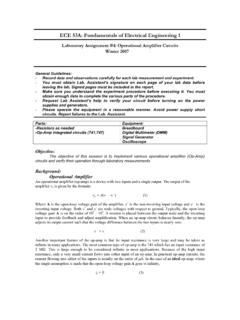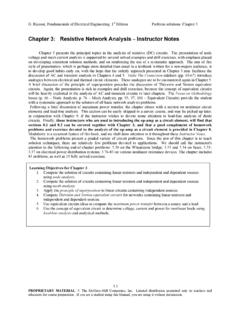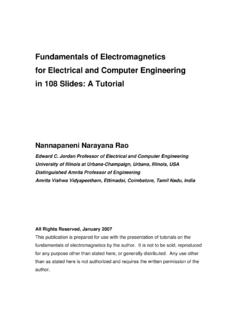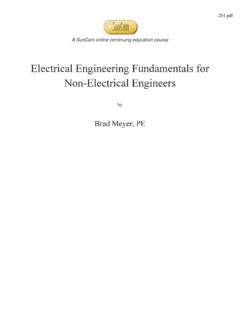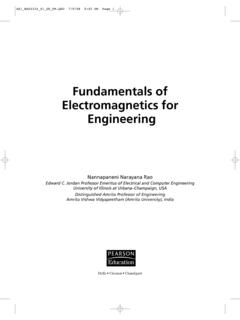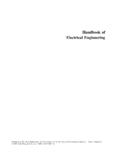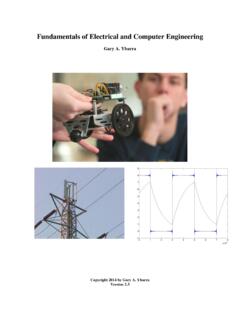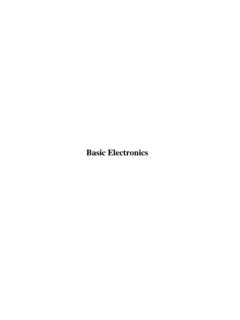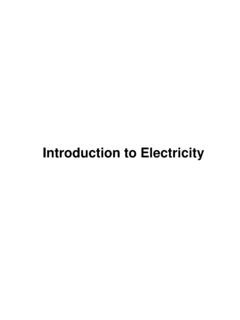Transcription of Fundamental of Electrical Engineering, Giorgio …
1 Fundamental of Electrical engineering , Giorgio rizzoni , mcgraw -Hill, 2009 Ideal Transformer Relations (Equations) Definitions: Primary Winding (input - subscript 1) Secondary Winding (output - subscript 2) Turns Ratio = n1 / n2 (number of turns on primary winding / number of turns on secondary winding) Voltage Ratio: V1 / V2 = n1 / n2 (Directly Proportional) Current Ratio: I1 / I2 = n2 / n1 (Inversely Proportional) Power Ratio: 1 to 1 (Power Out = Power In) Ideal Power Out = e x Power In where e is the Efficiency Factor (e < 1) Impedance Ratio: Z1 / Z2 = (n1 / n2) 2 For additional information, refer to Practical Electronics for Inventors, 2ed pp 386 - 392 Practical Electronics for Inventors, 3ed pp 374 - 402 Transformer Problems and Questions 1.
2 Given an ideal transformer with primary turns = 9600 and secondary turns = 480, assume 100% efficiency. For input voltage = 120 VAC and output impedance = 16 ohms; a. Calculate output voltage b. Calculate output current c. Calculate output power b. Calculate input current c. Calculate input power b. Calculate input impedance Page 1 of 2. Diode Characteristics Source: James Brophy, Basic Electronics for Scientists, 5th Edition Page 2 of 2. Diode Rectifiers, Clippers, and Clamps Source: James Brophy, Basic Electronics for Scientists, 5th Edition Diode Circuits Example Calculate V0 V = + IDR1 + + IDR2 V - - = ID(R1 + R2) ID = [V - ( + ) ] / (R1 + R2) ID = / (2000 + 1000) ID = mA V0 = + IDR2 V0 = + x 1000 = + = V Exercise Calculate V0 for V = 15 V, R1 = 2200 , R2 = 3300 Answer.
3 ID = mA V0 = V Example Calculate V0 +15 = + IDR1 + + IDR2 - 5 20 - - = ID(R1 + R2) ID = / (R1 + R2) ID = / (2200 + 3300) ID = mA V0 = + IDR2 - V0 = + x 3300 - = + - = V Exercise Calculate V0 for V1 = +10 V V2 = -5 V R1 = 1100 R2 = 2200 Answer: ID = mA V0 = V Diode Circuits - continued Example (Refer to the Diode Circuit Lecture Notes) Calculate the Current ID 1. Remove Diode (Replace by VTH) For Voltage Divider VTH = V [ R2 / (R1 + R2) ] VTH = 16 [ 4700 / (5100 + 4700) ] = V 2. Short Vsource (R1 in parallel with R2) REQ = (R1 x R2) / (R1 + R2) REQ = (5100 x 4700) / (5100 + 4700) = 2446 3.
4 Redraw with VTH, REQ, Diode VTH = IDREQ + VD ID = (VTH - VD) / REQ ID = ( - ) / 2446 = mA Alternative Solution Method VR2 = VD = V IR2 = VR2 / R2 = / 4700 = mA IR1 = (V - VR2 ) / R1 = ( - ) / 5100 = mA ITotal = IR1 ID = ITotal - IR2 = - = mA Exercise Calculate the Current ID Answer: ID = mA VD = V Scanned Images: Electronic Devices, Ali Aminian & Marian Kazimierczuk, Pearson-Prentice Hall, 2004





